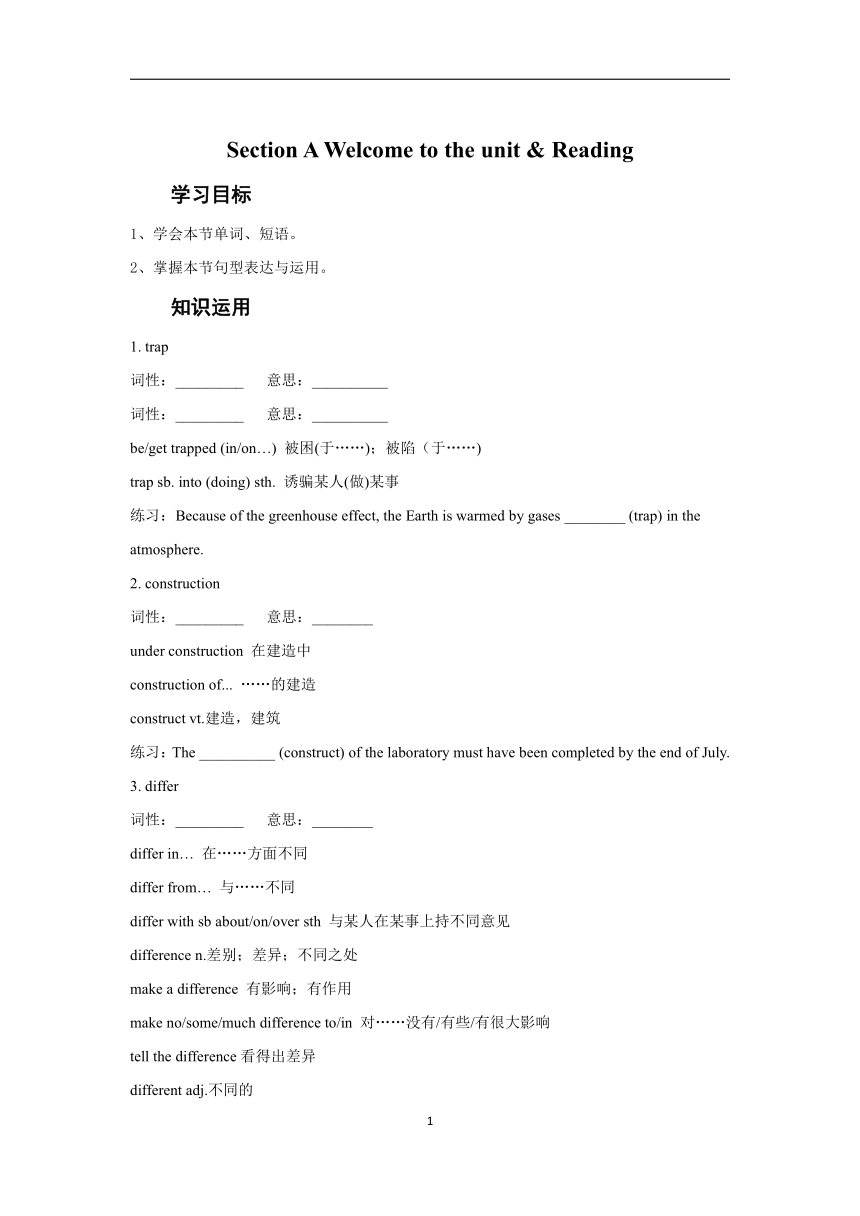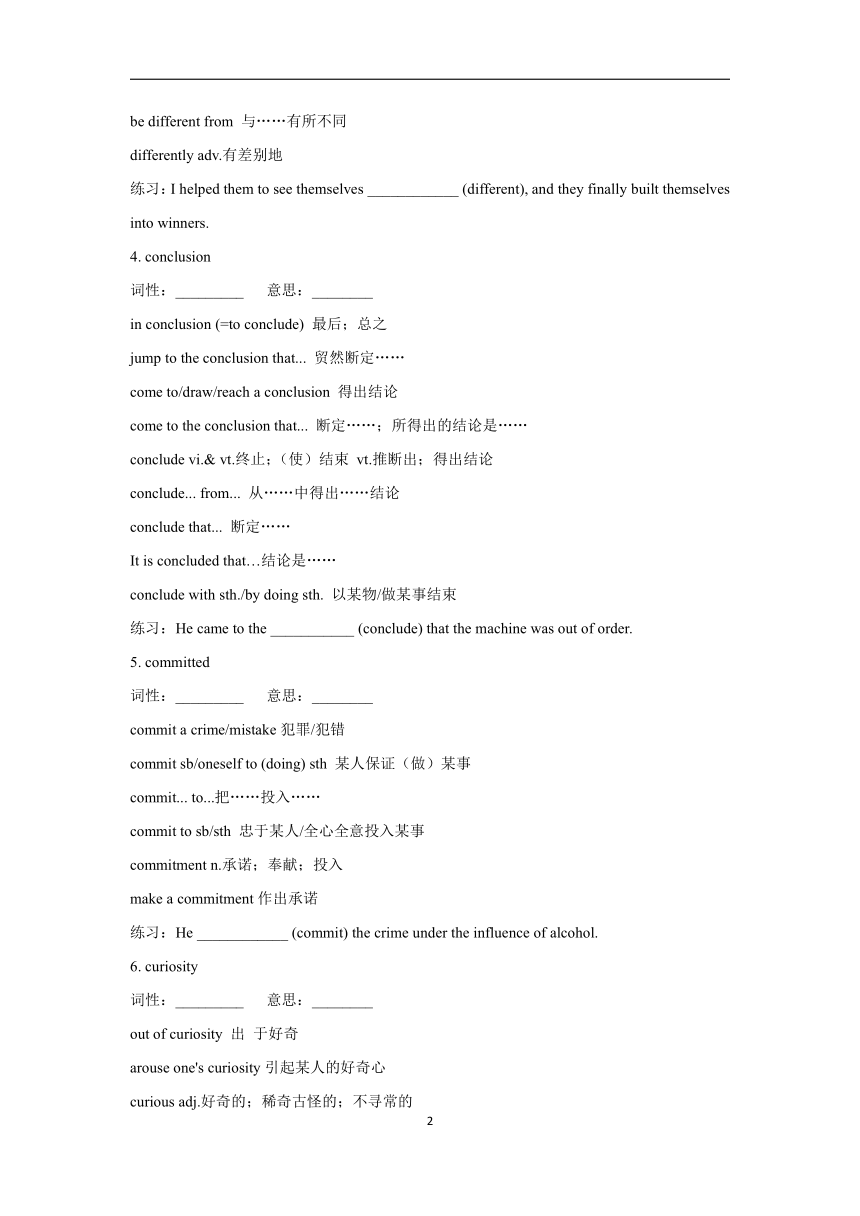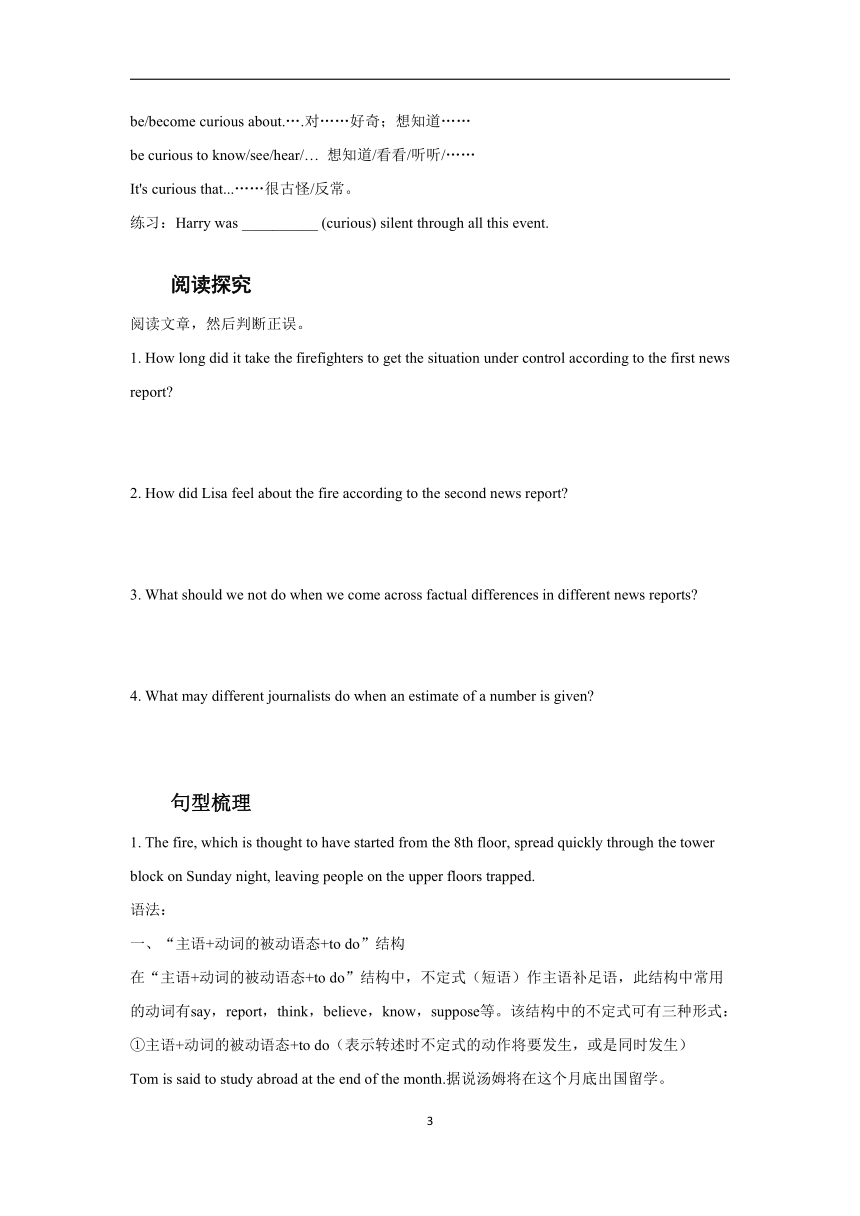牛津译林版(2019)选择性必修第二册Unit 1 The mass media Section A Welcome to the unit & Reading(学案)
文档属性
| 名称 | 牛津译林版(2019)选择性必修第二册Unit 1 The mass media Section A Welcome to the unit & Reading(学案) |  | |
| 格式 | doc | ||
| 文件大小 | 41.0KB | ||
| 资源类型 | 教案 | ||
| 版本资源 | 牛津译林版(2019) | ||
| 科目 | 英语 | ||
| 更新时间 | 2022-10-08 15:46:32 | ||
图片预览



文档简介
Section A Welcome to the unit & Reading
学习目标
1、学会本节单词、短语。
2、掌握本节句型表达与运用。
知识运用
1. trap
词性:_________ 意思:__________
词性:_________ 意思:__________
be/get trapped (in/on…) 被困(于……);被陷(于……)
trap sb. into (doing) sth. 诱骗某人(做)某事
练习:Because of the greenhouse effect, the Earth is warmed by gases ________ (trap) in the atmosphere.
2. construction
词性:_________ 意思:________
under construction 在建造中
construction of... ……的建造
construct vt.建造,建筑
练习:The __________ (construct) of the laboratory must have been completed by the end of July.
3. differ
词性:_________ 意思:________
differ in… 在……方面不同
differ from… 与……不同
differ with sb about/on/over sth 与某人在某事上持不同意见
difference n.差别;差异;不同之处
make a difference 有影响;有作用
make no/some/much difference to/in 对……没有/有些/有很大影响
tell the difference看得出差异
different adj.不同的
be different from 与……有所不同
differently adv.有差别地
练习:I helped them to see themselves ____________ (different), and they finally built themselves into winners.
4. conclusion
词性:_________ 意思:________
in conclusion (=to conclude) 最后;总之
jump to the conclusion that... 贸然断定……
come to/draw/reach a conclusion 得出结论
come to the conclusion that... 断定……;所得出的结论是……
conclude vi.& vt.终止;(使)结束 vt.推断出;得出结论
conclude... from... 从……中得出……结论
conclude that... 断定……
It is concluded that…结论是……
conclude with sth./by doing sth. 以某物/做某事结束
练习:He came to the ___________ (conclude) that the machine was out of order.
5. committed
词性:_________ 意思:________
commit a crime/mistake犯罪/犯错
commit sb/oneself to (doing) sth 某人保证(做)某事
commit... to...把……投入……
commit to sb/sth 忠于某人/全心全意投入某事
commitment n.承诺;奉献;投入
make a commitment作出承诺
练习:He ____________ (commit) the crime under the influence of alcohol.
6. curiosity
词性:_________ 意思:________
out of curiosity 出 于好奇
arouse one's curiosity引起某人的好奇心
curious adj.好奇的;稀奇古怪的;不寻常的
be/become curious about.….对……好奇;想知道……
be curious to know/see/hear/… 想知道/看看/听听/……
It's curious that...……很古怪/反常。
练习:Harry was __________ (curious) silent through all this event.
阅读探究
阅读文章,然后判断正误。
1. How long did it take the firefighters to get the situation under control according to the first news report
2. How did Lisa feel about the fire according to the second news report
3. What should we not do when we come across factual differences in different news reports
4. What may different journalists do when an estimate of a number is given
句型梳理
1. The fire, which is thought to have started from the 8th floor, spread quickly through the tower block on Sunday night, leaving people on the upper floors trapped.
语法:
一、“主语+动词的被动语态+to do”结构
在“主语+动词的被动语态+to do”结构中,不定式(短语)作主语补足语,此结构中常用的动词有say,report,think,believe,know,suppose等。该结构中的不定式可有三种形式:
①主语+动词的被动语态+to do(表示转述时不定式的动作将要发生,或是同时发生)
Tom is said to study abroad at the end of the month.据说汤姆将在这个月底出国留学。
②主语+动词的被动语态+to be doing(表示转述时不定式的动作正在发生)
He is supposed to be working hard.他应该在努力工作。
③主语+动词的被动语态+to have done(表示转述时不定式的动作已经发生)
Peter is said to have gone abroad.据说彼得已经出国了。
二、“leave+宾语+宾语补足语”结构
leave作使役动词时,表示“使/让(某人/某事物)处于某种状态”、其后可跟复合宾语结构。其中作宾语补足语的可以是名词、形容词、副词、介词短语、现在分词(短语)、不定式(短语)、过去分词(短语)等。可以用于这种结构的其他动词(短语)有see,hear,watch,observe,notice,feel,find,catch,look at,listen to,have,keep,get等。
Leave the door open, please.请让门开着吧。
I'm sorry I have left some questions unanswered.很抱歉,有些问题我没有回答。
This matter left her without a ray of hope.这件事使她没有一丝希望。
I left my English book at home once more.我又一次把英语书落在了家里。
If you leave the water running when you don't use it, you are wasting it.
当你不用水的时候还让它一直流着,你就是在浪费。
He left, leaving me to do all the rest of the work.他走了,留下我来做剩下的所有工作。
注意:
在“leave +宾语+宾语补足语”结构中,现在分词(短语)作宾语补足语,表示宾语与宾语补足语之间为逻辑上的主动关系;过去分词(短语)作宾语补足语,表示宾语与宾语补足语之间为逻辑上的被动关系;不定式(短语)作宾语补足语,表示该动作尚未发生。
I'd like to see the work finished tomorrow.我希望看到这个工作明天就可以完成。
He could hear his heart beating fast.他可以听见自己的心脏跳得很快
Jenny hopes that Mr Smith will suggest a good way to have her written English improved in a short period.
珍妮希望史密斯先生会提出一个好办法,让她在短期内提高英语写作水平。
The workers kept the machine working all the time.工人们让机器一直运转。
2. Fears grew that the number of deaths could reach 12, according to figures released by emergency services.
语法:that 引导的同位语从句
同位语从句一般跟在某些名词(belief,doubt,fact,hope,idea,news,possibility,promise等)后面,用以解释说明这些名词的内容。最常见的引导词是that,在从句中不作任何成分,但不能省略。此外,同位语从句的引导词还有how,when,where,why等,可翻译为相应含义。
I had no idea that he had already gone abroad.我不知道他已经出国了。
The text tells us a fact that smoking does great harm to people's health.
这篇文章告诉我们这样一个事实——吸烟非常不利于人的健康。
He can't answer the question how he got the money.他无法回答这笔钱是怎么得到的这个问题。
注意:
that引导的同位语从句最容易与定语从句相混淆。应注意,that引导同位语从句时,在从句中不作任何成分,但不能省略;而that引导定语从句时,在从句中必须充当成分,在从句中作主语时不可省略,在从句中作宾语时可以省略。
Have you heard the news that our team won the match 你听说我们队赢得比赛的消息了吗?(同位语从句,that在从句中不作成分)
The news that he told you wasn't true.他告诉你的那个消息不是真的。
(定语从句,that在从句中作told的宾语)
答案
知识运用
1. trapped 2. construction 3. differently 4. conclusion 5. committed 6. curiously
阅读探究
1. Around 75 minutes.
2. Terrible and awful.
3. Do not rush to the conclusion that one of the news reports gives false information.
4. Journalists may approach figures they get from research or interviews differently.
2
学习目标
1、学会本节单词、短语。
2、掌握本节句型表达与运用。
知识运用
1. trap
词性:_________ 意思:__________
词性:_________ 意思:__________
be/get trapped (in/on…) 被困(于……);被陷(于……)
trap sb. into (doing) sth. 诱骗某人(做)某事
练习:Because of the greenhouse effect, the Earth is warmed by gases ________ (trap) in the atmosphere.
2. construction
词性:_________ 意思:________
under construction 在建造中
construction of... ……的建造
construct vt.建造,建筑
练习:The __________ (construct) of the laboratory must have been completed by the end of July.
3. differ
词性:_________ 意思:________
differ in… 在……方面不同
differ from… 与……不同
differ with sb about/on/over sth 与某人在某事上持不同意见
difference n.差别;差异;不同之处
make a difference 有影响;有作用
make no/some/much difference to/in 对……没有/有些/有很大影响
tell the difference看得出差异
different adj.不同的
be different from 与……有所不同
differently adv.有差别地
练习:I helped them to see themselves ____________ (different), and they finally built themselves into winners.
4. conclusion
词性:_________ 意思:________
in conclusion (=to conclude) 最后;总之
jump to the conclusion that... 贸然断定……
come to/draw/reach a conclusion 得出结论
come to the conclusion that... 断定……;所得出的结论是……
conclude vi.& vt.终止;(使)结束 vt.推断出;得出结论
conclude... from... 从……中得出……结论
conclude that... 断定……
It is concluded that…结论是……
conclude with sth./by doing sth. 以某物/做某事结束
练习:He came to the ___________ (conclude) that the machine was out of order.
5. committed
词性:_________ 意思:________
commit a crime/mistake犯罪/犯错
commit sb/oneself to (doing) sth 某人保证(做)某事
commit... to...把……投入……
commit to sb/sth 忠于某人/全心全意投入某事
commitment n.承诺;奉献;投入
make a commitment作出承诺
练习:He ____________ (commit) the crime under the influence of alcohol.
6. curiosity
词性:_________ 意思:________
out of curiosity 出 于好奇
arouse one's curiosity引起某人的好奇心
curious adj.好奇的;稀奇古怪的;不寻常的
be/become curious about.….对……好奇;想知道……
be curious to know/see/hear/… 想知道/看看/听听/……
It's curious that...……很古怪/反常。
练习:Harry was __________ (curious) silent through all this event.
阅读探究
阅读文章,然后判断正误。
1. How long did it take the firefighters to get the situation under control according to the first news report
2. How did Lisa feel about the fire according to the second news report
3. What should we not do when we come across factual differences in different news reports
4. What may different journalists do when an estimate of a number is given
句型梳理
1. The fire, which is thought to have started from the 8th floor, spread quickly through the tower block on Sunday night, leaving people on the upper floors trapped.
语法:
一、“主语+动词的被动语态+to do”结构
在“主语+动词的被动语态+to do”结构中,不定式(短语)作主语补足语,此结构中常用的动词有say,report,think,believe,know,suppose等。该结构中的不定式可有三种形式:
①主语+动词的被动语态+to do(表示转述时不定式的动作将要发生,或是同时发生)
Tom is said to study abroad at the end of the month.据说汤姆将在这个月底出国留学。
②主语+动词的被动语态+to be doing(表示转述时不定式的动作正在发生)
He is supposed to be working hard.他应该在努力工作。
③主语+动词的被动语态+to have done(表示转述时不定式的动作已经发生)
Peter is said to have gone abroad.据说彼得已经出国了。
二、“leave+宾语+宾语补足语”结构
leave作使役动词时,表示“使/让(某人/某事物)处于某种状态”、其后可跟复合宾语结构。其中作宾语补足语的可以是名词、形容词、副词、介词短语、现在分词(短语)、不定式(短语)、过去分词(短语)等。可以用于这种结构的其他动词(短语)有see,hear,watch,observe,notice,feel,find,catch,look at,listen to,have,keep,get等。
Leave the door open, please.请让门开着吧。
I'm sorry I have left some questions unanswered.很抱歉,有些问题我没有回答。
This matter left her without a ray of hope.这件事使她没有一丝希望。
I left my English book at home once more.我又一次把英语书落在了家里。
If you leave the water running when you don't use it, you are wasting it.
当你不用水的时候还让它一直流着,你就是在浪费。
He left, leaving me to do all the rest of the work.他走了,留下我来做剩下的所有工作。
注意:
在“leave +宾语+宾语补足语”结构中,现在分词(短语)作宾语补足语,表示宾语与宾语补足语之间为逻辑上的主动关系;过去分词(短语)作宾语补足语,表示宾语与宾语补足语之间为逻辑上的被动关系;不定式(短语)作宾语补足语,表示该动作尚未发生。
I'd like to see the work finished tomorrow.我希望看到这个工作明天就可以完成。
He could hear his heart beating fast.他可以听见自己的心脏跳得很快
Jenny hopes that Mr Smith will suggest a good way to have her written English improved in a short period.
珍妮希望史密斯先生会提出一个好办法,让她在短期内提高英语写作水平。
The workers kept the machine working all the time.工人们让机器一直运转。
2. Fears grew that the number of deaths could reach 12, according to figures released by emergency services.
语法:that 引导的同位语从句
同位语从句一般跟在某些名词(belief,doubt,fact,hope,idea,news,possibility,promise等)后面,用以解释说明这些名词的内容。最常见的引导词是that,在从句中不作任何成分,但不能省略。此外,同位语从句的引导词还有how,when,where,why等,可翻译为相应含义。
I had no idea that he had already gone abroad.我不知道他已经出国了。
The text tells us a fact that smoking does great harm to people's health.
这篇文章告诉我们这样一个事实——吸烟非常不利于人的健康。
He can't answer the question how he got the money.他无法回答这笔钱是怎么得到的这个问题。
注意:
that引导的同位语从句最容易与定语从句相混淆。应注意,that引导同位语从句时,在从句中不作任何成分,但不能省略;而that引导定语从句时,在从句中必须充当成分,在从句中作主语时不可省略,在从句中作宾语时可以省略。
Have you heard the news that our team won the match 你听说我们队赢得比赛的消息了吗?(同位语从句,that在从句中不作成分)
The news that he told you wasn't true.他告诉你的那个消息不是真的。
(定语从句,that在从句中作told的宾语)
答案
知识运用
1. trapped 2. construction 3. differently 4. conclusion 5. committed 6. curiously
阅读探究
1. Around 75 minutes.
2. Terrible and awful.
3. Do not rush to the conclusion that one of the news reports gives false information.
4. Journalists may approach figures they get from research or interviews differently.
2
同课章节目录
